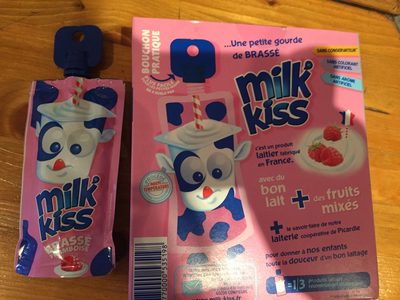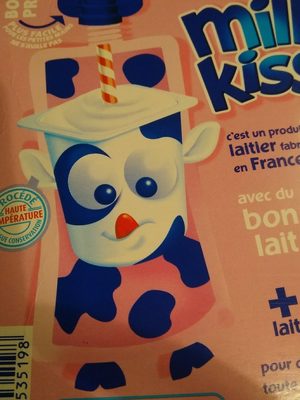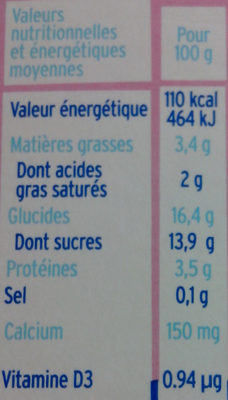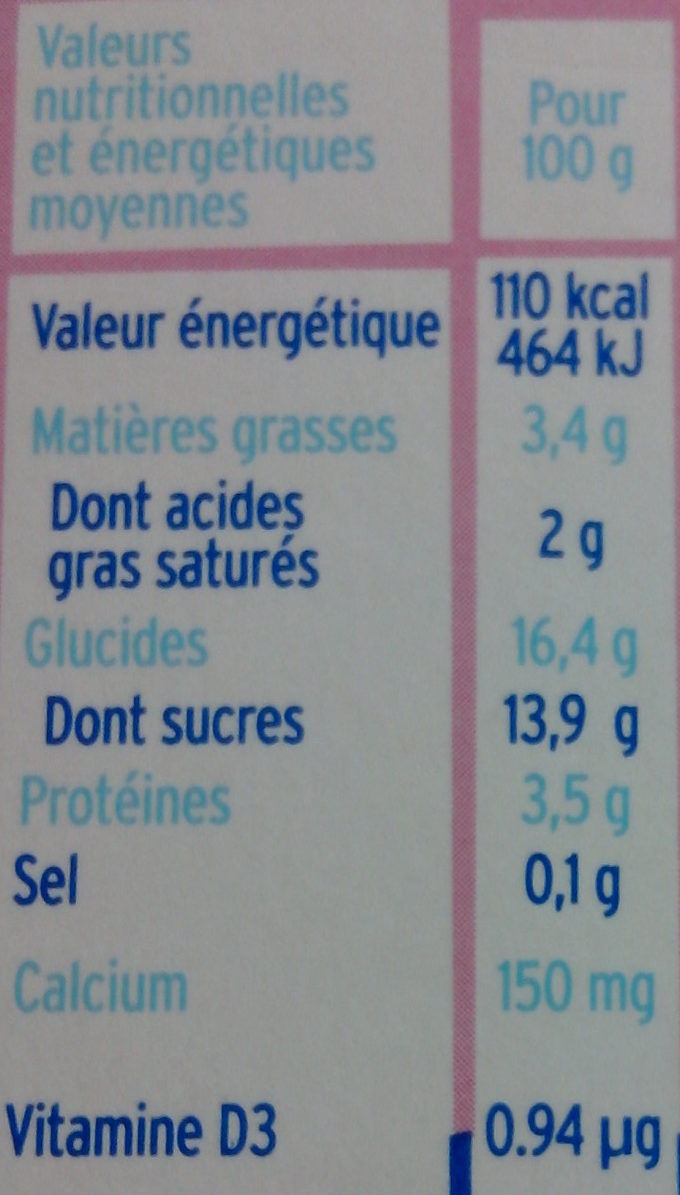Help us make food transparency the norm!
As a non-profit organization, we depend on your donations to continue informing consumers around the world about what they eat.
The food revolution starts with you!
Milk' kiss - Snyv - 480 g (6 * 80 g e)
Milk' kiss - Snyv - 480 g (6 * 80 g e)
This product page is not complete. You can help to complete it by editing it and adding more data from the photos we have, or by taking more photos using the app for Android or iPhone/iPad. Thank you!
×
Barcode: 3770000535198 (EAN / EAN-13)
Common name: Produit laitier à la framboise
Quantity: 480 g (6 * 80 g e)
Packaging: Plastic, Box, Cardboard
Brands: Snyv, Milk' kiss
Categories: Beverages, Dairies, Fermented foods, Fermented milk products, Desserts, Dairy desserts, Dairy drinks, Fermented dairy desserts, Milks, Fermented drinks, Yogurts, Fermented milk drinks, Unsweetened beverages, Drinkable yogurts, Sweetened beverages
Labels, certifications, awards: No artificial flavors, No preservatives, French milk, Made in France, No artificial colors, No artificial colours or flavours, No colorings
Origin of ingredients: France
Manufacturing or processing places: France
Traceability code: FR 80.001.008 CE - Abbeville (Somme, France)
Stores: Super U
Countries where sold: France
Matching with your preferences
Health
Ingredients
-
24 ingredients
: Lait entier (lait, crème) (74 %) ; sucre ; yaourt (5%) (dont lait) : purée de framboise (5 %) ; sirop de glucose-fructose ; amidon modifié ; protéines de lait ; acidifiant : acide lactique ; épaississants : pectine, caroube, gomme gellane ; arômes naturels (lait) ; concentré de minéraux du lait ; jus concentré de carotte pourpre; concentré de cassis, pomme et radis; vitamine D.Allergens: Milk
Food processing
-
Ultra processed foods
Elements that indicate the product is in the 4 - Ultra processed food and drink products group:
- Additive: E14XX - Modified Starch
- Additive: E418 - Gellan gum
- Additive: E440 - Pectins
- Ingredient: Flavouring
- Ingredient: Glucose
- Ingredient: Milk proteins
- Ingredient: Thickener
Food products are classified into 4 groups according to their degree of processing:
- Unprocessed or minimally processed foods
- Processed culinary ingredients
- Processed foods
- Ultra processed foods
The determination of the group is based on the category of the product and on the ingredients it contains.
Additives
-
E270 - Lactic acid
Lactic acid: Lactic acid is an organic compound with the formula CH3CH-OH-COOH. In its solid state, it is white and water-soluble. In its liquid state, it is colorless. It is produced both naturally and synthetically. With a hydroxyl group adjacent to the carboxyl group, lactic acid is classified as an alpha-hydroxy acid -AHA-. In the form of its conjugate base called lactate, it plays a role in several biochemical processes. In solution, it can ionize a proton from the carboxyl group, producing the lactate ion CH3CH-OH-CO−2. Compared to acetic acid, its pKa is 1 unit less, meaning lactic acid deprotonates ten times more easily than acetic acid does. This higher acidity is the consequence of the intramolecular hydrogen bonding between the α-hydroxyl and the carboxylate group. Lactic acid is chiral, consisting of two optical isomers. One is known as L--+--lactic acid or -S--lactic acid and the other, its mirror image, is D--−--lactic acid or -R--lactic acid. A mixture of the two in equal amounts is called DL-lactic acid, or racemic lactic acid. Lactic acid is hygroscopic. DL-lactic acid is miscible with water and with ethanol above its melting point which is around 17 or 18 °C. D-lactic acid and L-lactic acid have a higher melting point. In animals, L-lactate is constantly produced from pyruvate via the enzyme lactate dehydrogenase -LDH- in a process of fermentation during normal metabolism and exercise. It does not increase in concentration until the rate of lactate production exceeds the rate of lactate removal, which is governed by a number of factors, including monocarboxylate transporters, concentration and isoform of LDH, and oxidative capacity of tissues. The concentration of blood lactate is usually 1–2 mM at rest, but can rise to over 20 mM during intense exertion and as high as 25 mM afterward. In addition to other biological roles, L-lactic acid is the primary endogenous agonist of hydroxycarboxylic acid receptor 1 -HCA1-, which is a Gi/o-coupled G protein-coupled receptor -GPCR-.In industry, lactic acid fermentation is performed by lactic acid bacteria, which convert simple carbohydrates such as glucose, sucrose, or galactose to lactic acid. These bacteria can also grow in the mouth; the acid they produce is responsible for the tooth decay known as caries. In medicine, lactate is one of the main components of lactated Ringer's solution and Hartmann's solution. These intravenous fluids consist of sodium and potassium cations along with lactate and chloride anions in solution with distilled water, generally in concentrations isotonic with human blood. It is most commonly used for fluid resuscitation after blood loss due to trauma, surgery, or burns.Source: Wikipedia
-
E418 - Gellan gum
Gellan gum: Gellan gum is a water-soluble anionic polysaccharide produced by the bacterium Sphingomonas elodea -formerly Pseudomonas elodea based on the taxonomic classification at the time of its discovery-. Its taxonomic classification has been subsequently changed to Sphingomonas elodea based on current classification system. The gellan-producing bacterium was discovered and isolated by the former Kelco Division of Merck & Company, Inc. in 1978 from the lily plant tissue from a natural pond in Pennsylvania, USA. It was initially identified as a substitute gelling agent at significantly lower use level to replace agar in solid culture media for the growth of various microorganisms Its initial commercial product with the trademark as "GELRITE" gellan gum, was subsequently identified as a suitable agar substitute as gelling agent in various clinical bacteriological media.Source: Wikipedia
-
E440 - Pectins
Pectins (E440) are natural carbohydrates, predominantly found in fruits, that act as gelling agents in the food industry, creating the desirable jelly-like texture in jams, jellies, and marmalades.
Pectins stabilize and thicken various food products, such as desserts, confectioneries, and beverages, ensuring a uniform consistency and quality.
Recognized as safe by various health authorities, pectins have been widely used without notable adverse effects when consumed in typical dietary amounts.
Ingredients analysis
-
Palm oil free
No ingredients containing palm oil detected
-
Non-vegan
Non-vegan ingredients: Whole milk, Milk, Cream, Yogurt, Milk, Milk proteins, Milk, Milk mineral concentrate
-
Vegetarian status unknown
Unrecognized ingredients: Vitamin D
-
Details of the analysis of the ingredients
: _Lait_ entier (_lait_, _crème_), sucre, yaourt 5% (dont _lait_, purée de framboise 5%), sirop de glucose-fructose, amidon modifié, protéines de _lait_, acidifiant (acide lactique), épaississants (pectine), caroube, gomme gellane, arômes naturels (_lait_), concentré de minéraux du _lait_, jus concentré de carotte pourpre, cassis, pomme, radis, vitamine D- _Lait_ entier -> en:whole-milk - vegan: no - vegetarian: yes - ciqual_food_code: 19023
- _lait_ -> en:milk - vegan: no - vegetarian: yes - ciqual_proxy_food_code: 19051
- _crème_ -> en:cream - vegan: no - vegetarian: yes - ciqual_food_code: 19402
- sucre -> en:sugar - vegan: yes - vegetarian: yes - ciqual_proxy_food_code: 31016
- yaourt -> en:yogurt - vegan: no - vegetarian: yes - ciqual_proxy_food_code: 19593 - percent: 5
- dont _lait_ -> en:milk - vegan: no - vegetarian: yes - ciqual_proxy_food_code: 19051
- purée de framboise -> en:raspberry-puree - vegan: maybe - vegetarian: maybe - ciqual_food_code: 13015 - percent: 5
- sirop de glucose-fructose -> en:glucose-fructose-syrup - vegan: yes - vegetarian: yes - ciqual_food_code: 31077
- amidon modifié -> en:modified-starch - vegan: yes - vegetarian: yes - ciqual_proxy_food_code: 9510
- protéines de _lait_ -> en:milk-proteins - vegan: no - vegetarian: yes
- acidifiant -> en:acid
- acide lactique -> en:e270 - vegan: yes - vegetarian: yes
- épaississants -> en:thickener
- pectine -> en:e440a - vegan: yes - vegetarian: yes
- caroube -> en:carob-bean-locust-bean - vegan: yes - vegetarian: yes
- gomme gellane -> en:e418 - vegan: yes - vegetarian: yes
- arômes naturels -> en:natural-flavouring - vegan: maybe - vegetarian: maybe
- _lait_ -> en:milk - vegan: no - vegetarian: yes - ciqual_proxy_food_code: 19051
- concentré de minéraux du _lait_ -> en:milk-mineral-concentrate - vegan: no - vegetarian: yes
- jus concentré de carotte pourpre -> en:concentrated-black-carrot-juice - vegan: yes - vegetarian: yes - ciqual_food_code: 20009
- cassis -> en:blackcurrant - vegan: yes - vegetarian: yes - ciqual_food_code: 13007
- pomme -> en:apple - vegan: yes - vegetarian: yes - ciqual_food_code: 13050
- radis -> en:radish - vegan: yes - vegetarian: yes - ciqual_food_code: 20045
- vitamine D -> en:vitamin-d
en:milk -> en:milk
- _Lait_ entier -> en:whole-milk - vegan: no - vegetarian: yes - ciqual_food_code: 19023
Nutrition
-
Average nutritional quality
⚠ ️Warning: the amount of fiber is not specified, their possible positive contribution to the grade could not be taken into account.⚠ ️Warning: the amount of fruits, vegetables and nuts is not specified on the label, it was estimated from the list of ingredients: 5This product is not considered a beverage for the calculation of the Nutri-Score.
Positive points: 2
- Proteins: 2 / 5 (value: 3.3, rounded value: 3.3)
- Fiber: 0 / 5 (value: 0, rounded value: 0)
- Fruits, vegetables, nuts, and colza/walnut/olive oils: 0 / 5 (value: 5.34912109375, rounded value: 5.3)
Negative points: 5
- Energy: 1 / 10 (value: 460, rounded value: 460)
- Sugars: 3 / 10 (value: 13.9, rounded value: 13.9)
- Saturated fat: 1 / 10 (value: 2, rounded value: 2)
- Sodium: 0 / 10 (value: 40, rounded value: 40)
The points for proteins are counted because the negative points are less than 11.
Nutritional score: (5 - 2)
Nutri-Score:
-
Nutrient levels
-
Fat in moderate quantity (3.3%)
What you need to know- A high consumption of fat, especially saturated fats, can raise cholesterol, which increases the risk of heart diseases.
Recommendation: Limit the consumption of fat and saturated fat- Choose products with lower fat and saturated fat content.
-
Saturated fat in moderate quantity (2%)
What you need to know- A high consumption of fat, especially saturated fats, can raise cholesterol, which increases the risk of heart diseases.
Recommendation: Limit the consumption of fat and saturated fat- Choose products with lower fat and saturated fat content.
-
Sugars in high quantity (13.9%)
What you need to know- A high consumption of sugar can cause weight gain and tooth decay. It also augments the risk of type 2 diabetes and cardio-vascular diseases.
Recommendation: Limit the consumption of sugar and sugary drinks- Sugary drinks (such as sodas, fruit beverages, and fruit juices and nectars) should be limited as much as possible (no more than 1 glass a day).
- Choose products with lower sugar content and reduce the consumption of products with added sugars.
-
Salt in low quantity (0.1%)
What you need to know- A high consumption of salt (or sodium) can cause raised blood pressure, which can increase the risk of heart disease and stroke.
- Many people who have high blood pressure do not know it, as there are often no symptoms.
- Most people consume too much salt (on average 9 to 12 grams per day), around twice the recommended maximum level of intake.
Recommendation: Limit the consumption of salt and salted food- Reduce the quantity of salt used when cooking, and don't salt again at the table.
- Limit the consumption of salty snacks and choose products with lower salt content.
-
-
Nutrition facts
Nutrition facts As sold
for 100 g / 100 mlAs sold
per serving (80 g)Compared to: Drinkable yogurts Energy 460 kj
(110 kcal)368 kj
(88 kcal)+61% Fat 3.3 g 2.64 g +148% Saturated fat 2 g 1.6 g +150% Carbohydrates 17 g 13.6 g +60% Sugars 13.9 g 11.1 g +42% Fiber ? ? Proteins 3.3 g 2.64 g +13% Salt 0.1 g 0.08 g -7% Vitamin D 0.94 µg 0.752 µg -4% Fruits‚ vegetables‚ nuts and rapeseed‚ walnut and olive oils (estimate from ingredients list analysis) 5.349 % 5.349 %
Environment
-
Eco-Score D - High environmental impact
⚠ ️Select a country in order to include the full impact of transportation.The Eco-Score is an experimental score that summarizes the environmental impacts of food products.→ The Eco-Score was initially developped for France and it is being extended to other European countries. The Eco-Score formula is subject to change as it is regularly improved to make it more precise and better suited to each country.Life cycle analysis
-
Average impact of products of the same category: D (Score: 37/100)
Category: Dairy drink or fermented milk or yogurt, flavoured, with sugar
Category: Dairy drink or fermented milk or yogurt, flavoured, with sugar
- PEF environmental score: 0.22 (the lower the score, the lower the impact)
- including impact on climate change: 1.67 kg CO2 eq/kg of product
Stage Impact Agriculture
53.5 %Processing
14.5 %Packaging
18.4 %Transportation
8.3 %Distribution
4.1 %Consumption
1.1 %
Bonuses and maluses
-
Origins of ingredients with a medium impact
Bonus: +4
Environmental policy: +4
Transportation: 0
Origin of the product and/or its ingredients % of ingredients Impact France 100 %Medium
-
Packaging with a medium impact
Malus: -11
Shape Material Recycling Impact Box Plastic High Unknown Cardboard Low ⚠ ️ The information about the packaging of this product is not sufficiently precise (exact shapes and materials of all components of the packaging).⚠ ️ For a more precise calculation of the Eco-Score, you can modify the product page and add them.
If you are the manufacturer of this product, you can send us the information with our free platform for producers.
Eco-Score for this product
-
Impact for this product: D (Score: 30/100)
Product: Milk' kiss - Snyv - 480 g (6 * 80 g e)
Life cycle analysis score: 37
Sum of bonuses and maluses: -7
Final score: 30/100
-
Carbon footprint
-
Equal to driving 0.9 km in a petrol car
167 g CO² per 100g of product
The carbon emission figure comes from ADEME's Agribalyse database, for the category: Dairy drink or fermented milk or yogurt, flavoured, with sugar (Source: ADEME Agribalyse Database)
Stage Impact Agriculture
62.6 %Processing
9.8 %Packaging
11.0 %Transportation
14.0 %Distribution
2.2 %Consumption
0.4 %
Packaging
-
Packaging with a medium impact
-
Packaging parts
Box (Plastic)
(Cardboard)
-
Packaging materials
Material % Packaging weight Packaging weight per 100 g of product Paper or cardboard Plastic Total
-
Transportation
-
Origins of ingredients
Origins of ingredients with a medium impact
Origin of the product and/or its ingredients % of ingredients Impact France 100 %Medium
Report a problem
-
Incomplete or incorrect information?
Category, labels, ingredients, allergens, nutritional information, photos etc.
If the information does not match the information on the packaging, please complete or correct it. Open Food Facts is a collaborative database, and every contribution is useful for all.
Data sources
Product added on by melanie11
Last edit of product page on by packbot.
Product page also edited by beniben, kiliweb, openfoodfacts-contributors, roboto-app, taztempest, vaporous, yuka.WktNNEMvOGJvT1VNdTh3WXBoLzMxY3B4M2NTVlczbXRGckFTSWc9PQ, yuka.YjRrOE5wMHZnZG9YeGZjeG9DL2wvZk1wM0xDM0JrNlRKY293SVE9PQ.











